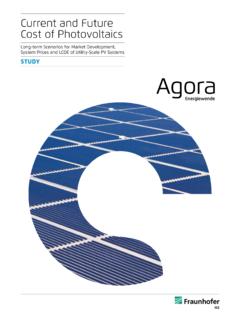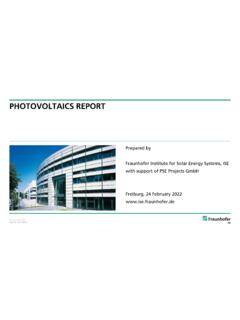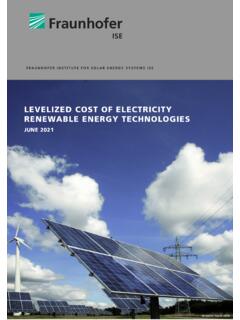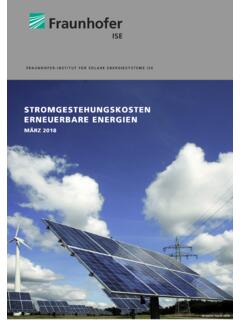Transcription of Recent Facts about Photovoltaics in Germany
1 1 (101) Recent Facts about Photovoltaics in Germany Current version available at Compiled by Dr. Harry Wirth Division Director Photovoltaics Modules and Power Plants Fraunhofer ISE Contact: Karin Schneider Press and Public Relations Phone +49 761 4588-5147 Fraunhofer Institute for Solar Energy Systems ISE Heidenhofstrasse 2 79110 Freiburg, Germany Citation note: Recent Facts about Photovoltaics in Germany , Harry Wirth, Fraunhofer ISE, download from , version of May 15, 2021 2 (101) Table of Contents 1 What purpose does this guide serve? .. 5 2 Will we achieve the expansion targets?
2 5 3 Does PV contribute significantly to the power supply? .. 6 4 Is PV power too expensive? .. 6 Levelized Cost of Energy .. 7 Feed-in Tariff .. 9 Pricing on the energy exchange and the merit order effect ..11 Determining the Differential Costs ..14 Privileged Electricity Consumers ..15 EEG Surcharge ..15 5 Subventions and Electricity Prices .. 17 Is PV power subsidized? ..17 Are fossil fuel and nuclear power production subsidized? ..17 Fossil energy sources .. 18 Nuclear power .. 19 Do tenants subsidize well-positioned home owners? ..20 Does PV make electricity more expensive for householders? ..20 Does PV increase the electricity price for industry?
3 22 6 Are we exporting large amounts of PV power to other European nations? 23 7 Can small PV systems generate attractive returns? .. 24 8 Does installing PV only create jobs in Asia? .. 26 9 Are large energy suppliers interested in PV? .. 27 10 Is PV research taking up high levels of funding? .. 30 11 Does PV power overload our energy system? .. 30 Transmission and distribution ..30 Volatility ..32 Solar power production is predictable .. 32 Peak production is significantly lower than installed PV capacity .. 33 Solar and wind energy complement each other .. 33 Controllability ..35 Conflicts with slow-response fossil and nuclear power plants.
4 35 3 (101) Does volatile solar power endanger security of supply? ..37 Does the expansion of PV have to wait for more storage? ..37 12 Does the manufacture of PV modules consume more energy than they can produce? .. 38 13 Is there enough space for PV in Germany ? .. 39 14 Do PV systems destroy ecologically valuable areas? .. 42 15 Do PV power plants find acceptance in the population? .. 43 16 Are PV plants in Germany efficient? .. 44 Do PV plants degrade? ..45 Can PV modules become soiled? ..46 Do PV plants often operate at full capacity? ..46 17 Does PV make relevant contributions to climate protection? .. 49 Do anthropogenic CO2 emissions danger the climate?
5 49 Does PV make a significant contribution to reducing the CO2 emissions? ..51 In addition to CO2 are there other environmentally harmful gases released during the production of PV? ..54 Do dark PV modules warm up the Earth through their absorption? ..54 18 Are PV systems capable of replacing fossil fuel and nuclear power plants? 55 19 Are we capable of covering a significant proportion of our energy demand with PV power? .. 55 Energy demand and supply ..55 Energy scenarios ..59 Transformation measures ..63 Keeping PV power production constant .. 63 Complementary operation of power plants .. 65 Increasing the energy efficiency.
6 66 Load management .. 68 Balanced expansion of PV and wind power capacities .. 69 Cogeneration of power and heat .. 69 Energy storage .. 70 Grid expansion .. 76 Overview .. 77 Does the energy transformation have to wait for federal policy? ..80 20 Do we need PV production in Germany ? .. 80 21 Does it still need a Renewable Energy Sources Act (EEG)? .. 81 22 Do PV modules contain toxic substances? .. 82 Wafer-based modules ..82 Thin-film modules ..82 4 (101) Solar glass ..82 Take-back schemes and recycling ..82 23 Are there enough raw materials available for PV production? .. 83 Wafer-based modules ..83 Thin-film modules.
7 83 24 Do PV plants increase the risk of fire? .. 83 Can defective PV plants cause a fire? ..83 Do PV plants pose a danger to firefighters? ..84 Do PV modules prevent firefighters from extinguishing fires externally from the roof? ..85 Are toxic emissions released when PV modules burn? ..85 25 Appendix: Terminology .. 86 EEG surcharge ..86 Module efficiency ..87 Rated power of a PV power plant ..87 Specific yield ..87 System efficiency ..87 Performance ratio ..87 Base load, intermediate load, peak load, grid load and residual load ..88 Electricity generation and consumption ..88 26 Appendix: Conversion tables [EEBW].
8 90 27 Appendix: Abbreviations .. 91 28 Appendix: Sources .. 91 29 Appendix: Figures .. 99 5 (101) 1 What purpose does this guide serve? Germany is leaving the fossil-nuclear age behind, paving the way for Photovoltaics (PV) to play a central role in a future shaped by sustainable power production. This compilation of current Facts , figures and findings is regularly updated. It aims to help in creating an overall assessment of PV growth in Germany . 2 Will we achieve the expansion targets? The annual target of the German Federal Government for PV capacity increase of GW was exceeded in 2020, but the goals of the energy transformation are still far away.
9 On May 12, 2021, the German government approved climate targets that call for a bal-anced national greenhouse gas footprint by 2045 at the latest. In order to cover all of our energy needs from renewable energies (RE), a massive expan-sion of the installed PV power is necessary, along with a number of other measures. More Recent model-based scenarios calculate a reduction of energy-related greenhouse gas emissions alone of at least 90% in relation to 1990, with a PV expansion corridor of 130-650 GWp nominal capacity ([Prog], [BCG], [ESYS], [ISE11], [UBA8], [IRENA], [ISE12]). The scenarios make different assumptions about boundary conditions, for energy imports and questions of acceptance.
10 Based on the scenarios "reference" and "inac-ceptance" [ISE12], a magnitude of 500 GWp installed PV capacity seems to be plausible. If we calculate a PV expansion to 500 GWp by 2045, an average of 18 GWp of PV will have to be added annually. Increasingly, old systems must also be replaced. These replace-ment installations are currently still of little importance, but they will increase to around 17 GWp per year when fully expanded, assuming a lifetime of 30 years. The German Renewable Energy Sources Act [EEG2021] defines an interim target for 2030 of a share of renewable energies (RE) of 65 percent of gross electricity consumption.











